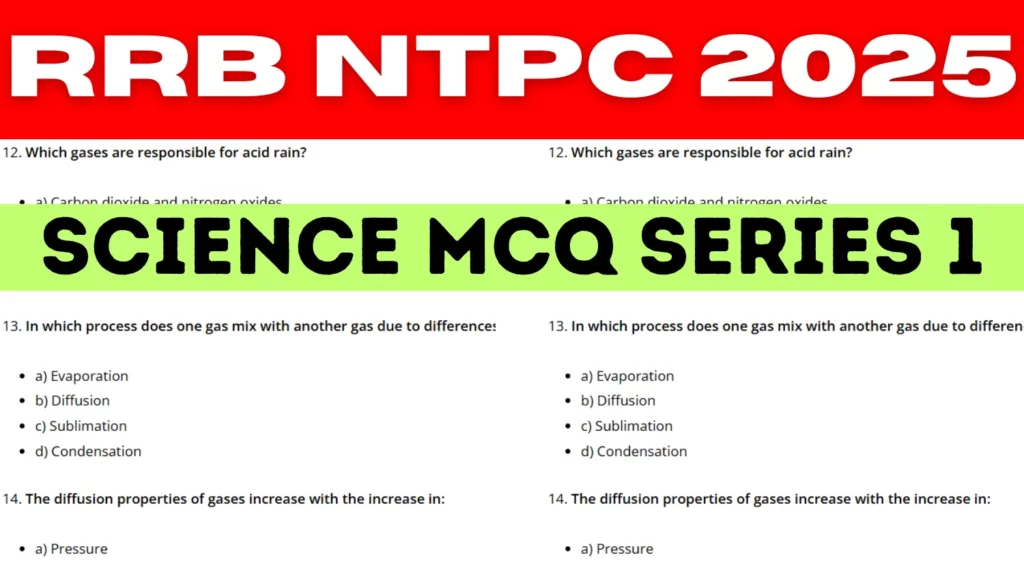RRB NTPC 2025 Science MCQ Series 1: The RRB NTPC (Railway Recruitment Board Non-Technical Popular Categories) exam is one of the most competitive exams for candidates seeking non-technical positions in Indian Railways. Among its key sections, General Studies (GS) plays a crucial role, covering diverse topics such as current affairs, history, geography, general science, economics, and more.
In this MCQ Series 1, we have gathered some of the most important and frequently asked questions that are expected to appear in the RRB NTPC GS section. Practicing these questions will help candidates enhance their knowledge and boost their exam preparation. Covering a wide range of topics, this set allows aspirants to revise key concepts and assess their understanding of crucial subjects essential for the RRB NTPC General Studies section.
RRB NTPC 2025 Science MCQ Series 1
1. Why is Carbon Dioxide (CO₂) gas filled in cold drinks?
- a) It increases the sweetness
- b) It reacts with water to form carbonic compounds
- c) It adds color to the drink
- d) It acts as a preservative
2. Which gas is an allotrope of oxygen?
- a) Ozone
- b) Carbon dioxide
- c) Nitrogen
- d) Argon
3. The most common unit for measuring ozone concentration is:
- a) Pascal
- b) Dobson unit
- c) Atmosphere
- d) Mole
4. What prevents ultraviolet rays from reaching the Earth?
- a) Carbon dioxide
- b) Ozone layer
- c) Nitrogen
- d) Water vapor
5. What is causing the depletion of the ozone layer?
- a) Methane
- b) Chlorofluorocarbons (CFCs)
- c) Carbon monoxide
- d) Nitrogen oxides
6. Which gas is emitted from refrigerators and air conditioners?
- a) Nitrous oxide
- b) Chlorofluorocarbons (CFCs)
- c) Carbon monoxide
- d) Ammonia
7. What is commonly referred to as laughing gas?
- a) Nitrogen
- b) Carbon dioxide
- c) Nitrous oxide (N₂O)
- d) Helium
8. What is another name for Freon?
- a) Nitrogen gas
- b) Chlorofluorocarbons (CFCs)
- c) Ozone
- d) Carbon monoxide
9. What is the primary use of CFCs?
- a) Food preservatives
- b) Insecticides
- c) Refrigerants and aerosol propellants
- d) Fertilizers
10. Which poisonous gas was used in World War II?
- a) Sarin
- b) Chlorine
- c) Lewisite
- d) Hydrogen cyanide
Also Read:
11. What is the name of tear gas?
- a) Ammonia
- b) Chloropicrin (CCl₃NO₂)
- c) Hydrogen chloride
- d) Mustard gas
12. Which gases are responsible for acid rain?
- a) Carbon dioxide and nitrogen oxides
- b) Sulfur dioxide, nitrogen dioxide, and carbon monoxide
- c) Oxygen and ozone
- d) Hydrogen and methane
13. In which process does one gas mix with another gas due to differences in density?
- a) Evaporation
- b) Diffusion
- c) Sublimation
- d) Condensation
14. The diffusion properties of gases increase with the increase in:
- a) Pressure
- b) Temperature
- c) Density
- d) Volume
15. Compared to solids and liquids, gases are:
- a) Less compressible
- b) Highly compressible
- c) Incompressible
- d) Not affected by pressure
16. Under what conditions does a gas condense?
- a) High pressure and low temperature
- b) Low pressure and high temperature
- c) Low pressure and low temperature
- d) High pressure and high temperature
17. What is the rate of diffusion of a gas?
- a) The volume it occupies
- b) The amount of gas that expands in unit time
- c) The pressure it exerts
- d) The temperature of the gas
18. According to Graham’s law of diffusion, the rate of expansion of gases is inversely proportional to:
- a) The square root of its temperature
- b) The square root of its density or molar mass
- c) The square of its pressure
- d) Its volume
19. According to Avogadro’s Law, the number of molecules in a given volume of gas at NTP is:
- a) Proportional to the pressure
- b) Proportional to the temperature
- c) The same for all gases
- d) Inversely proportional to the volume
20. Boyle’s Law states that the pressure of a fixed quantity of gas at constant temperature is:
- a) Directly proportional to its volume
- b) Inversely proportional to its volume
- c) Inversely proportional to its temperature
- d) Unaffected by the volume
Also Read:
Answers to the RRB NTPC 2025 Science MCQ Series 1
Here are the answers to the RRB NTPC GS MCQ Series 1:
- b) Inversely proportional to its volume
- b) It reacts with water to form carbonic compounds
- a) Ozone
- b) Dobson unit
- b) Ozone layer
- b) Chlorofluorocarbons (CFCs)
- b) Chlorofluorocarbons (CFCs)
- c) Nitrous oxide (N₂O)
- b) Chlorofluorocarbons (CFCs)
- c) Refrigerants and aerosol propellants
- c) Lewisite
- b) Chloropicrin (CCl₃NO₂)
- b) Sulfur dioxide, nitrogen dioxide, and carbon monoxide
- b) Diffusion
- b) Temperature
- b) Highly compressible
- a) High pressure and low temperature
- b) The amount of gas that expands in unit time
- b) The square root of its density or molar mass
- c) The same for all gases
আপনি কি বাংলা কবিতা পড়তে ভালোবাসেন, তাহলে এই লিঙ্কে ক্লিক করুন : www.raateralo.com
